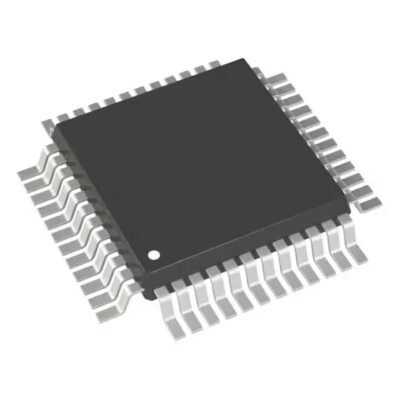STM8S003K3T6C
Part Number: STM8S003K3T6C
Manufacturer: STMicroelectronics
Description: IC MCU 8BIT 8KB FLASH 32LQFP
Shipped from: Shenzhen/HK Warehouse
Stock Available: Check with us
ICRFQ.com - Electronic Components Distributor in China Since 2003

Part Number: STM8S003K3T6C
Manufacturer: STMicroelectronics
Description: IC MCU 8BIT 8KB FLASH 32LQFP
Shipped from: Shenzhen/HK Warehouse
Stock Available: Check with us
| Datasheet | |
|---|---|
| Category | Integrated Circuits (ICs) |
| Family | Embedded – Microcontrollers |
| Manufacturer | STMicroelectronics |
| Series | STM8S |
| Packaging | Tray |
| Part Status | Active |
| Core Processor | STM8 |
| Core Size | 8-Bit |
| Speed | 16MHz |
| Connectivity | I2C, IrDA, LIN, SPI, UART/USART |
| Peripherals | Brown-out Detect/Reset, POR, PWM, WDT |
| Number of I/O | 28 |
| Program Memory Size | 8KB (8K x 8) |
| Program Memory Type | FLASH |
| EEPROM Size | 128 x 8 |
| RAM Size | 1K x 8 |
| Voltage – Supply (Vcc/Vdd) | 2.95 V ~ 5.5 V |
| Data Converters | A/D 4x10b |
| Oscillator Type | Internal |
| Operating Temperature | -40°C ~ 85°C (TA) |
| Package / Case | 32-LQFP |
| Supplier Device Package | 32-LQFP (7×7) |
The STM8S003K3T6C microcontroller from STMicroelectronics is a powerful 8-bit microcontroller. In this guide, we’ll look at what this microcontroller can do and how it works, as well as what it means for developing embedded systems. We will also talk about the “value line” and the benefits it has for making plans that are good for the money.
Embedded systems are built into a lot of the electronics we use every day, from home tools to car systems. 8-bit microcontrollers are a key part of these systems because of how well and reliably they can do basic computing jobs. They are great for a wide range of applications because they offer a good mix of performance, power efficiency, and cost.
8-bit microcontrollers are great for devices that run on batteries or applications where room is limited because they are small and use little power. They can do simple control jobs, connect to sensors, and process data, which makes it possible for embedded systems to have many different functions.
The STM8S003K3T6C microcontroller has a variety of specs and features that make it a flexible choice for embedded systems. Here is a summary of its most important specs and features:
The microcontroller has a maximum frequency of 16 MHz, which lets it run commands quickly and efficiently.
Flash Memory: The STM8S003K3T6C has an 8 KB flash memory, which is plenty of room for storing programs.
EEPROM: It also has a 128-byte EEPROM (Electrically Erasable Programmable Read-Only Memory) for storing data that won’t disappear when the power goes out.
RAM: The microprocessor has 1 KB of RAM for storing temporary data while the program runs.
General Purpose Input/Output (GPIO): The STM8S003K3T6C has a set of GPIO pins that can be set up as inputs or outputs to connect to devices and sensors outside the chip.
USART stands for Universal Synchronous/Asynchronous Receiver Transmitter. This link lets the microcontroller and other devices send and receive data in a serial fashion.
SPI, or Serial Peripheral Interface, is a way for peripheral devices to talk to each other using a synchronous serial system.
I2C (Inter-Integrated Circuit): Using a two-wire serial system, the I2C interface lets you talk to other devices like sensors and external memory.
Timers: The STM8S003K3T6C has a number of timers, both general-purpose and “watchdog” clocks. These timers let you set exact times, start events, and keep track of time.
Interrupts: The microcontroller can handle multiple interrupt sources, which makes it easier to handle events from the outside world and lessens the need to ask all the time.
With these specs and features, the STM8S003K3T6C microcontroller has all the tools it needs to connect to other devices, process data, and control things quickly. Because it has a lot of memory, a variety of peripheral ports, and both timers and interrupts, it can be used in a wide range of embedded systems, such as industrial automation, consumer electronics, Internet of Things (IoT) devices, and more.
CPU Core and Instruction Set: The STM8S003K3T6C microcontroller is based on the STM8 core, which is an advanced 8-bit core architecture intended for high performance and low power consumption. The STM8 core is based on a Harvard design, which means that program and data memory are accessed by separate buses.
The STM8S003K3T6C microcontroller’s instruction set is built on an 8-bit RISC (Reduced Instruction Set Computer) architecture that is small and fast. It has a wide range of instructions for working with data, doing math, controlling the flow of the program, and handling I/O.
Memory Organization: This is how the memory is set up on the STM8S003K3T6C microcontroller:
The STM8S003K3T6C microcontroller is a flexible and inexpensive way to make embedded systems work. With an 8-bit architecture, many peripheral interfaces, and a lot of memory, it is easy to handle, process data, and connect to other devices. It is very useful because it works well, uses little power, and is cheap. Explore what it can do, use its features to your advantage, and come up with innovative ideas. Contact ICRFQ to find out more or to place an order.
WhatsApp us